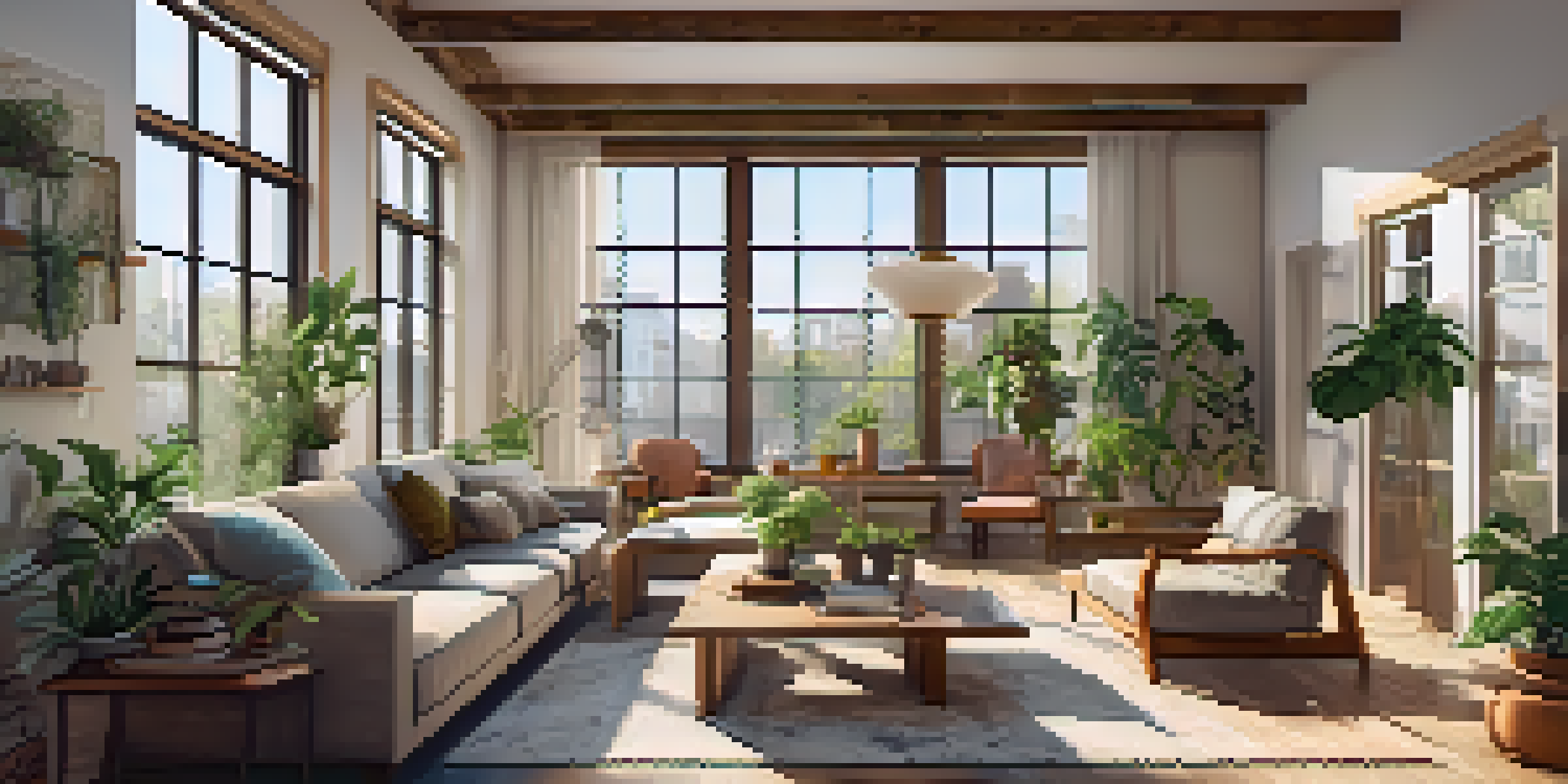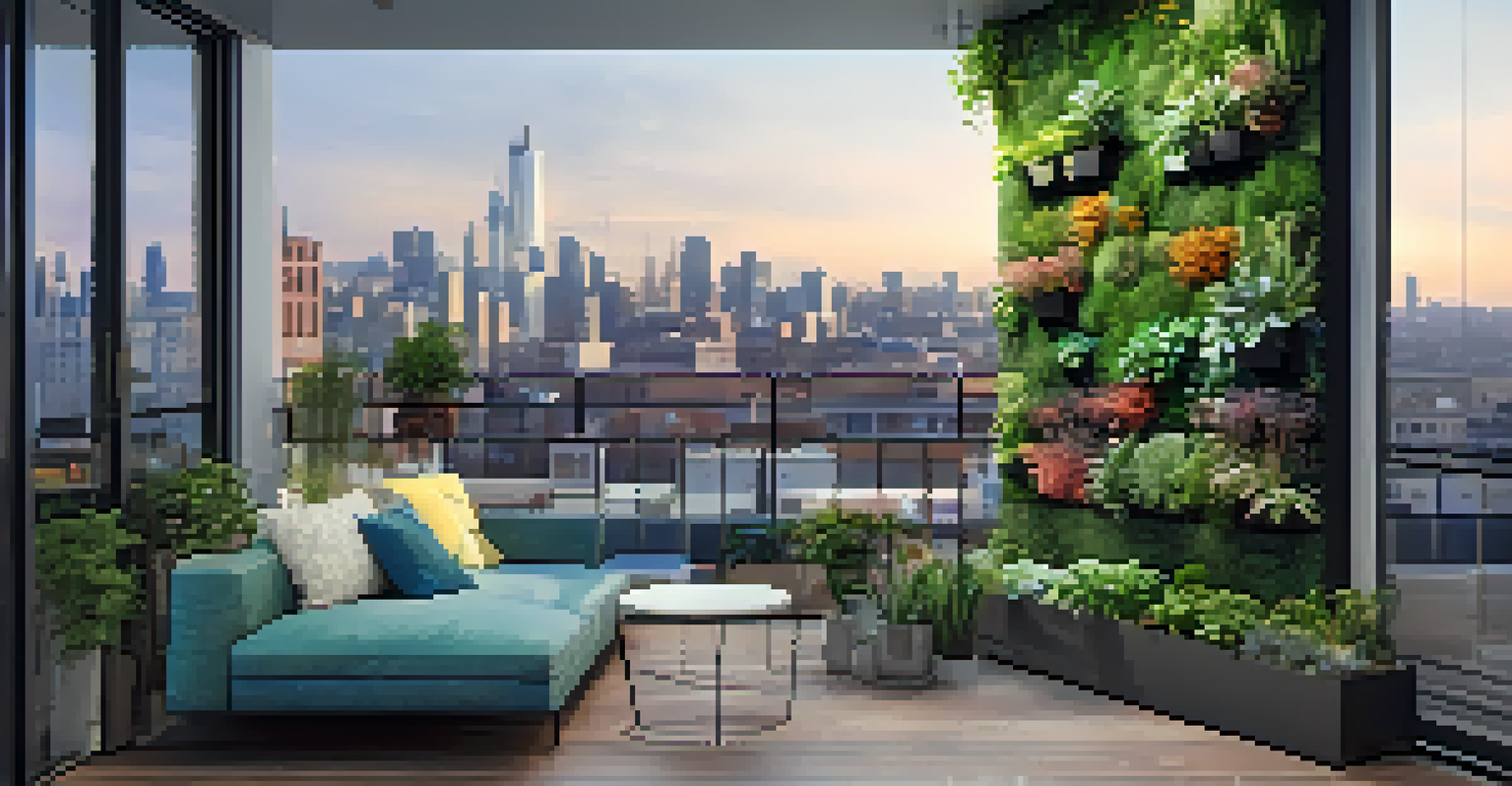Sustainable Home Design for Urban Dwellers

Understanding Sustainable Home Design
Sustainable home design focuses on creating living spaces that are environmentally friendly and resource-efficient. For urban dwellers, this means using materials and strategies that minimize waste and energy consumption. The goal is to create homes that not only look good but also contribute to a healthier planet.
The greatest threat to our planet is the belief that someone else will save it.
Think of your home as a small ecosystem where every choice impacts the whole. By selecting sustainable materials like reclaimed wood or bamboo, you can reduce your carbon footprint while adding unique character to your space. It’s about making mindful decisions that benefit both your lifestyle and the environment.
Ultimately, sustainable design isn’t just a trend; it’s a necessity for urban living. As cities grow and resources become scarcer, adopting sustainable practices in our homes can lead to significant changes in the way we live and interact with our surroundings.
Maximizing Natural Light in Your Home
One of the simplest ways to enhance sustainability is by maximizing natural light. This not only reduces the need for artificial lighting but also creates a warm and inviting atmosphere. Consider using large windows, skylights, or even light tubes to bring the sun's rays into your living space.

When planning your layout, think about how the sun moves throughout the day. Positioning your living areas to face south or west can capture the most sunlight, which is especially beneficial in colder months. Additionally, using lighter colors for walls and furnishings can help reflect light, making your space feel larger and more open.
Embrace Sustainable Home Design
Sustainable home design focuses on eco-friendly materials and energy-efficient strategies to create healthier living spaces.
Embracing natural light also contributes to your well-being. Studies have shown that exposure to daylight can improve mood, productivity, and overall health. So, by designing your home with light in mind, you’re not just saving energy; you're enhancing your quality of life.
Choosing Eco-Friendly Materials
When it comes to sustainable home design, the materials you use can make a huge difference. Opting for eco-friendly materials such as recycled metal, reclaimed wood, or low-VOC (volatile organic compound) paints can help minimize your environmental impact. These choices not only reduce waste but also promote healthier indoor air quality.
Sustainability is not just about the environment; it’s about our future and the future of our children.
For example, bamboo is a great choice for flooring and cabinetry because it’s renewable and grows quickly. Similarly, recycled glass can be used in countertops or backsplashes, adding a stylish touch while being kind to the planet. These materials often have unique textures and colors, making your home truly one-of-a-kind.
Ultimately, choosing sustainable materials is a win-win situation. You get to create a beautiful, personalized space while also making choices that benefit the earth. By being mindful of your selections, you’ll contribute to a more sustainable future.
Incorporating Green Spaces into Urban Living
Urban environments can sometimes feel concrete-heavy, but incorporating green spaces into your home can create a refreshing balance. Even if you have limited outdoor space, options like vertical gardens, balcony plants, or indoor greenery can significantly enhance your living area. These natural elements not only beautify your home but also improve air quality.
Consider adding potted plants or hanging herbs in your kitchen. Not only do they serve as beautiful decor, but they also provide fresh ingredients for your meals. Plus, caring for plants can be a therapeutic activity, reducing stress and enhancing your connection to nature.
Maximize Natural Light Benefits
Maximizing natural light in your home not only saves energy but also enhances mood and well-being.
Creating green spaces is also about fostering biodiversity. Planting native species can attract local wildlife and pollinators, supporting the ecosystem around you. So, even in an urban setting, you have the power to make a positive impact on nature.
Energy Efficiency: Saving Money and Resources
Energy efficiency is a cornerstone of sustainable home design, especially for urban dwellers looking to save on utility bills. Simple changes like installing energy-efficient appliances, sealing windows and doors, and using smart thermostats can significantly reduce energy consumption. These upgrades not only help the environment but also lower your costs in the long run.
For instance, LED lighting uses a fraction of the energy compared to traditional bulbs and lasts much longer. By swapping out just a few fixtures, you can see immediate savings and make a positive impact on your energy use. Additionally, consider investing in solar panels if your building allows it; they can drastically reduce reliance on non-renewable energy sources.
By prioritizing energy efficiency, you're taking tangible steps toward a more sustainable lifestyle. It’s a practical approach that benefits both your wallet and the planet, creating a win-win situation for everyone.
Water Conservation Techniques for Urban Homes
Water conservation is another essential aspect of sustainable home design, particularly in urban areas where resources can be limited. Simple measures like installing low-flow faucets and showerheads or collecting rainwater can significantly reduce water waste. These small changes not only save money but also promote responsible water usage.
Consider incorporating drought-resistant plants in your garden or balcony, which require less water to thrive. This approach not only conserves water but also creates a low-maintenance, beautiful outdoor space. Additionally, using mulch in garden beds can help retain moisture and reduce the need for frequent watering.
Foster Community for Sustainability
Engaging with your community amplifies the impact of sustainable living through shared resources and collaborative initiatives.
By being mindful of your water usage, you contribute to a more sustainable urban environment. Every drop counts, and making conscious choices about water conservation can lead to a more sustainable future for our cities.
Creating a Flexible, Multi-Functional Space
In urban living, space is often at a premium, which makes it essential to create flexible, multi-functional areas in your home. Designing spaces that can easily transition from one use to another can enhance functionality and reduce clutter. For example, choosing furniture that doubles as storage or using room dividers can help create distinct areas without sacrificing space.
Consider a foldable desk that can be tucked away when not in use or a Murphy bed that transforms your bedroom into a living area during the day. These smart solutions maximize your square footage while maintaining a comfortable and stylish environment. It’s about making the most of what you have.

By embracing multi-functional design, you not only optimize your living space but also promote a more sustainable lifestyle. Less clutter means less consumption, and that’s a significant step toward reducing your environmental impact.
The Importance of Community in Sustainable Living
Sustainable home design doesn’t just stop at individual homes; it extends to the community as a whole. Engaging with your neighbors and local organizations can create a network of support for sustainable initiatives. Whether it’s sharing resources, participating in community gardens, or advocating for local green policies, collaboration amplifies the impact of sustainable living.
Consider joining or forming a neighborhood group focused on sustainability. This could involve organizing recycling drives, promoting carpooling, or hosting workshops on eco-friendly practices. When people come together, they can make a larger collective impact than they might achieve alone.
Ultimately, fostering a sense of community can enhance your urban living experience. It creates connections, encourages sharing, and builds a stronger, more sustainable future for everyone involved. Remember, we’re all in this together.